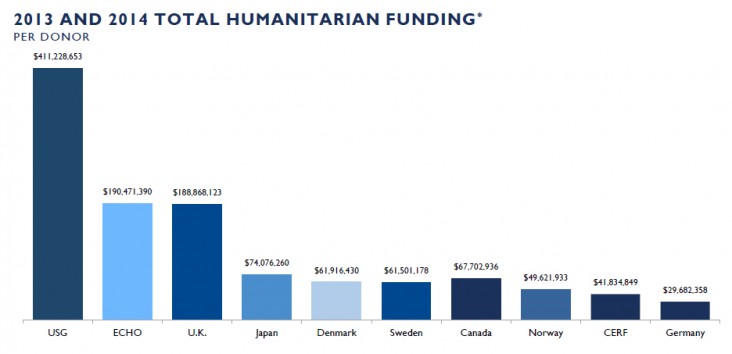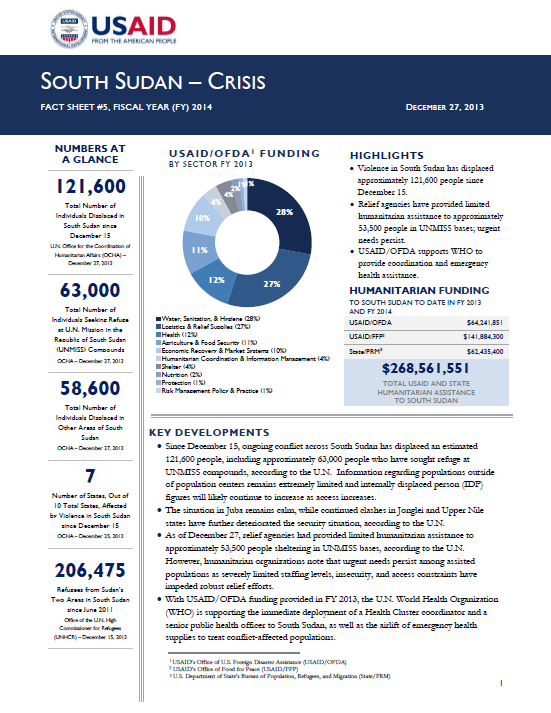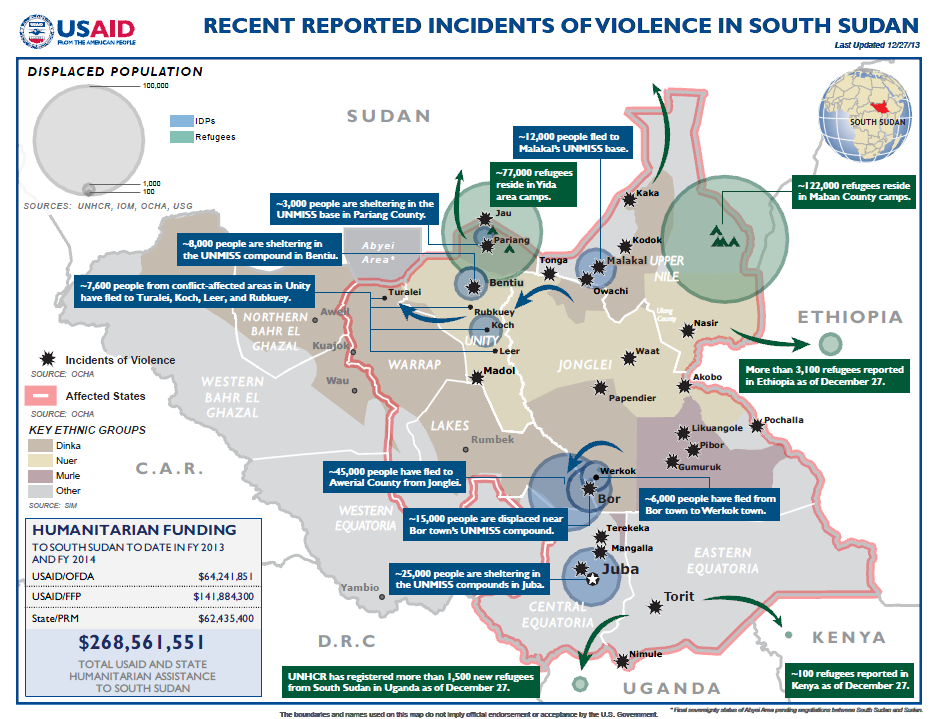- What We Do
- Agriculture and Food Security
- Democracy, Human Rights and Governance
- Economic Growth and Trade
- Education
- Environment and Global Climate Change
- Gender Equality and Women's Empowerment
- Global Health
- Humanitarian Assistance
- Transformation at USAID
- Water and Sanitation
- Working in Crises and Conflict
- U.S. Global Development Lab
Speeches Shim
February 7, 2014
Numbers At A Glance
738,400
74,800
663,200
130,400
230,800
Humanitarian Funding:
To South Sudan To Date In FY2013 and FY2014:
| USAID/OFDA | $87,008,426 |
| USAID/FFP | $141,884,300 |
| State/PRMDoD | $94,735,400 |
| TOTAL | $323,628,126 |
Highlights
Since December 15, violence has internally displaced approximately 738,000 people across South Sudan.
Clashes persist in Unity State, further impeding humanitarian access.
Relief agencies continue to expand humanitarian activities to reach additional conflict-affected populations.
KEY DEVELOPMENTS
At present, approximately 738,000 South Sudanese remain internally displaced as a result of the violence that began on December 15, and an additional 130,400 people are seeking refuge in neighboring countries. The number of internally displaced persons (IDPs) has decreased slightly since February 3 as some civilians have left the UNMISS bases in Bor town, Jonglei State, and Malakal town, Upper Nile State, in recent days.
During the week of February 3, USAID/OFDA transported approximately 67 metric tons (MT) of relief commodities—including 1,000 rolls of plastic sheeting and 4,500 emergency hygiene kits—from Nairobi, Kenya, to Juba. International non-governmental organization (INGO) World Vision plans to distribute the supplies to conflict-affected populations in Malakal County, Upper Nile, to provide shelter assistance for approximately 10,000 families and respond to water, sanitation, health and hygiene (WASH) needs of 4,500 households.
USAID/OFDA partner the U.N. Children’s Fund (UNICEF) declared a Level Three Emergency in South Sudan on February 6, which allows UNICEF’s global headquarters to prioritize enhanced support to the country and provide greater capacity to address critical humanitarian needs. UNICEF continues to facilitate the provision of urgently-needed health, nutrition, protection, and WASH services to conflict-affected people across South Sudan.
SITUATION, DISPLACEMENT, AND HUMANITARIAN NEEDS UPDATE
As the security situation improves in some previously conflict-affected areas of South Sudan, relief agencies began conducting needs assessments and distributing additional humanitarian assistance to previously inaccessible populations including in Bentiu town, Unity State; Bor; and Malakal, according to the U.N.
Relief agencies continue to monitor food insecurity across South Sudan, expressing concern that ongoing fighting will likely erode coping mechanisms and result in deteriorating food security conditions. According to the U.N. World Food Program (WFP), market disruptions caused by persistent hostilities will likely contribute to food insecurity in the coming months as most South Sudanese households remain highly dependent on markets to meet basic food needs. Due to insecurity, traders are reportedly unwilling to sell their commodities in markets, particularly in conflict-affected areas of Jonglei, Unity, and Upper Nile. In addition, prices of essential food commodities—including sorghum and maize—have risen by approximately 30 percent in markets in Juba, Central Equatoria, and Rumbek town, Lakes state, since December 15. Even if hostilities cease, WFP notes that markets, trade inflows, and overall food security are likely to continue to experience negative impacts from the conflict.
As of February 6, WFP estimates that unknown armed groups have looted approximately 4,400 MT of food commodities—enough food to feed more than 265,000 people for one month.
Approximately 1.6 million people will require nutrition assistance in South Sudan, particularly in states at high risk for malnutrition, including Jonglei, Northern Bahr el Ghazal, Unity, Upper Nile, Warrap, and Western Bahr el Ghazal states, according to the Nutrition Cluster—the coordinating body for humanitarian nutrition activities, comprising U.N. agencies, non-governmental organizations (NGOs), and other stakeholders. The approaching April-to-August rainy season is likely to prolong nutrition needs as access challenges and poor infrastructure could further hinder the humanitarian response.
Many conflict-affected areas are at a high risk of disease outbreaks due to increased population displacement, overcrowding, inadequate availability of safe drinking water, poor sanitation conditions, limited access to health care services, and food shortages, according to the Health Cluster. Health agencies have recorded nearly 550 suspected measles cases and more than 80 measles-related deaths across IDP areas—including UNMISS civilian protection sites and other IDP settlements—since hostilities began on December 15. The U.N. World Health Organization (WHO) reports that 57 percent of the deaths occurred at the UNMISS Tong Ping compound in Juba and 34 percent at the UNMISS compound in Bor. Although relief agencies recently halted relocation efforts to move IDPs from the overcrowded Tong Ping site to U.N. House 3 to prevent further spread of disease, health agencies have recorded at least four suspected measles cases in U.N. House 3 in recent days.
Displaced populations continue to flee Unity, through Abiemnom town, toward other areas of relative safety, including Abyei Area and Northern Bahr el Ghazal and Warrap states. Although fighting has not severely affected Abiemnom in recent weeks, clashes in the area have interrupted markets and trade, and INGOs report that approximately 2,000 IDPs currently in Abiemnom require humanitarian support to include food, livelihoods support, medical supplies, nutritional screening, and WASH assistance.
Since December 15, clashes between Government of the Republic of South Sudan (RSS) and opposition forces in Mayom town, Unity, have displaced populations, destroyed community infrastructure, and disrupted basic services and livelihoods activities. According to the U.N., vulnerable populations are adopting negative coping strategies, such as consuming seed stocks, while the continued presence of armed groups is preventing civilians from returning to areas of origin. Urgent needs include food assistance, primary health care, relief commodities, and shelter.
South Sudan Crisis Fact Sheet #25 February 7, 2014 ![]() (pdf - 380k)
(pdf - 380k)
South Sudan Crisis Map February 7, 2014 ![]() (pdf - 434k)
(pdf - 434k)
HUMANITARIAN RESPONSE ACTIVITIES
In response to recent measles outbreaks and measles-related deaths across IDP areas, UNICEF has supported the vaccination of nearly 91,000 children against measles and polio and collaborated with WHO to expand health activities for IDPs, particularly those sheltering at UNMISS bases in Bor and Juba. WHO has deployed surveillance teams across the country to enable early detection and investigation of suspected measles cases and has recruited community volunteers to support health promotion activities. In addition, UNICEF is coordinating with other relief agencies to scale up the nutrition response and plans to support infant and young child feeding in Awerial County, Lakes; Bor; Juba; and Twic County, Warrap. To date in FY 2014, USAID/OFDA has provided $4 million to UNICEF for nutrition, protection, and WASH activities.
In response to increased nutrition needs across South Sudan resulting from recent hostilities, Nutrition Cluster partners are conducting rapid needs assessments and coordinating emergency nutrition activities focused in Juba and parts of Jonglei, Lakes, Unity, Upper Nile, and Warrap. Priorities include managing and preventing acute malnutrition in children under five years of age and pregnant and lactating women, blanket supplementary food programs, infant feeding, and micronutrient supplements.
To date, relief agencies have distributed emergency food assistance to approximately 227,000 food insecure people across nine states since December 15, according to the U.N. However, relief agencies note that access to vulnerable populations remains a challenge and additional food assistance is needed to comprehensively meet humanitarian needs.
Central Equatoria
As the situation in Juba and the rest of Central Equatoria remained calm during the week of February 3, health actors increased efforts to improve the health situation in the Tong Ping UNMISS base—currently sheltering more than 27,500 IDPs—by constructing an additional 200 latrines. In an effort to reach additional displaced and conflict-affected populations in Central Equatoria, relief organizations began a three-day needs assessment in Bungu, Ganzi, Lainya, and Yei towns on February 5.
Eastern Equatoria
In Nimule town, Eastern Equatoria, where nearly 35,000 IDPs have integrated into the host community as of January 24, INGO CARE and USAID/FFP partner WFP are securing resources to conduct comprehensive supplementary feeding programs, and INGOs Merlin and Médecins Sans Frontières (MSF) are managing acute malnutrition cases.
Jonglei
As a result of the relatively calm security situation in Jonglei, the U.N. reports that the number of people at the Bor UNMISS base continues to decrease, and that additional displaced people in Bor have expressed interest in returning to their villages of origin. Relief agencies are expanding efforts to assess humanitarian needs in remote locations with significant IDP populations.
USAID/FFP partner WFP distributed one-week food rations and other relief commodities to more than 5,000 IDPs sheltering at the Bor UNMISS compound on February 3 and 4. WFP and other relief agencies also began an assessment of Bor town on February 5 to prepare for the possible return of civilians. However, USAID/OFDA partner Catholic Relief Services reports that, although some civilians who fled to Awerial County, during previous fighting have begun returning, Bor town remains largely deserted, and local infrastructure has suffered significant damage.
INGO Polish Humanitarian Action recently conducted a needs assessment—accompanied by local authorities—in Lankien town, Jonglei, where approximately 16,000 IDPs were reportedly sheltering as of January 30. As the influx of IDPs to Lankien has strained already limited host community resources, populations lack adequate access to safe drinking water, food, shelter, and WASH resources. The assessment indicated that an additional 100 latrines and basic relief commodities—including blankets, chlorine tablets, kitchen sets, mosquito nets, and water containers—are needed to meet immediate needs. MSF is currently operating a health care clinic in Lankien town, providing access to safe drinking water and rehabilitating damaged boreholes.
Lakes
Although violence in Rumbek East County temporarily suspended movement on the road between Rumbek and Yirol towns, the humanitarian response—including health, nutrition and WASH support—continued in Mingkaman town and surrounding areas of Awerial County for an estimated 84,000 displaced people.
Unity
Ongoing fighting in Unity, particularly in Guit, Leer, and Mayom counties, continues to hinder humanitarian access and prevent emergency assistance from reaching conflict-affected populations in the area. However, aid agencies recently gained access to Bentiu town, identifying severe food security concerns and signs of child malnutrition.
Local authorities and health actors re-opened the hospital in Bentiu during the week of January 27, finding that most of the structures and medical materials inside the hospital remained intact despite recent fighting. With the available medical supplies at the hospital, MSF plans to resume tuberculosis and HIV treatment activities in the coming days.
On January 30, INGOs conducted rapid needs assessments in Abiemnom and Mayom counties in order to address urgent food, health care, and shelter needs. Despite challenges, including high population mobility and poor access to remote areas, relief agencies are currently exploring options to provide emergency relief assistance to IDPs and host communities in these areas.
Upper Nile
As population movement remains fluid in Upper Nile, the U.N. reports the number of people sheltering in the Malakal UNMISS base has decreased from approximately 28,000 to 21,600 since February 3. Relief agencies continue to provide assistance at the UNMISS base and plan to conduct food and relief commodity distributions in Malakal town, where host community food resources have diminished due to IDP influxes. International Medical Corps is also re-establishing nutrition activities, such as malnutrition screening and acute malnutrition management.
In an effort to address key health care gaps due to previous insecurity in Malakal, health care workers have resumed surgical activities at the Malakal Teaching Hospital and primary health care services at other displacement sites in the town. With support from USAID/OFDA, the International Organization for Migration (IOM) re-opened a health clinic in Malakal on January 26 and conducted more than 1,900 consultations between January 27 and February 2.
OTHER HUMANITARIAN ASSISTANCE
To address increased humanitarian needs, the U.N. released a revised South Sudan Crisis Response Plan on February 3, identifying $1.27 billion in humanitarian funding needs. The $1.27 billion requirement includes $741 million to secure all core pipelines for the remainder of the year and $443 million for front-line services through June. Of the funding requested in the revised crisis response plan, more than 50 percent would support the Food Security and Livelihoods Cluster to address emergency food needs. To date, relief organizations have secured approximately $246 million for the South Sudan Crisis Response Plan.

*Funding figures are as of February 4, 2014. All international figures are according to OCHA’s Financial Tracking Service (FTS) and based on international commitments during the 2013 and 2014 calendar years. USG figures are according to the USG and reflect the most recent USG commitments based on the 2013 fiscal year, which began on October 1, 2012, and ended September 30, 2013, as well as the 2014 fiscal year, which began on October 1, 2013.



Comment
Make a general inquiry or suggest an improvement.